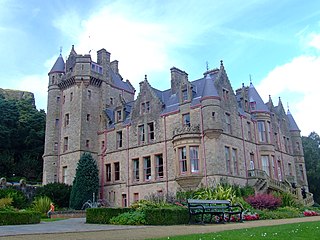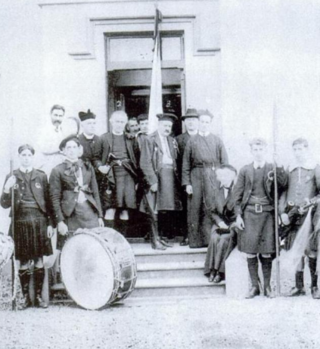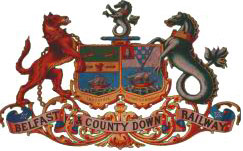
Limavady is a market town in County Londonderry, Northern Ireland, with Binevenagh as a backdrop. Lying 17 miles (27 km) east of Derry and 14 miles (23 km) southwest of Coleraine, Limavady had a population of 12,032 people at the 2011 Census. In the 40 years between 1971 and 2011, Limavady's population nearly doubled. Limavady is within Causeway Coast and Glens Borough.

County Down is one of the six counties of Northern Ireland, one of the nine counties of Ulster and one of the traditional thirty-two counties of Ireland. It covers an area of 961 sq mi (2,490 km2) and has a population of 531,665. It borders County Antrim to the north, the Irish Sea to the east, County Armagh to the west, and County Louth across Carlingford Lough to the southwest.

James Henry Molyneaux, Baron Molyneaux of Killead, KBE, PC was a Northern Irish unionist politician who served as leader of the Ulster Unionist Party (UUP) from 1979 to 1995, and as the Member of Parliament (MP) for South Antrim from 1970 to 1983, and later Lagan Valley from 1983 to 1997. An Orangeman, he was also Sovereign Grand Master of the Royal Black Institution from 1971 to 1995, and a leading member of the Conservative Monday Club.
Comber is a town in County Down, Northern Ireland. It lies 5 miles (8 km) south of Newtownards, at the northern end of Strangford Lough. It is situated in the townland of Town Parks, the civil parish of Comber and the historic barony of Castlereagh Lower. Comber is part of the Ards and North Down Borough. It is also known for Comber Whiskey which was last distilled in 1953. A notable native was Thomas Andrews, the designer of the RMS Titanic and was among the many who went down with her. Comber had a population of 9,071 people in the 2011 Census.

John Miller Andrews, was the second prime minister of Northern Ireland from 1940 to 1943.

Doagh is a village and townland in County Antrim, Northern Ireland. It is in the Six Mile Water Valley, about two miles south-west of Ballyclare, and had a population of 1,388 people in the 2011 census. It is known as Doach in Scots.

Belfast Castle is a mansion located in Cave Hill Country Park in Belfast, Northern Ireland, in a prominent position 400 feet (120 m) above sea level. Its location provides unobstructed views over the City of Belfast and Belfast Lough. There have been several different structures called 'Belfast Castle' over the centuries, located on different sites. The current 'castle' is a Victorian structure, built between 1867 and 1870 on the slopes of Cave Hill, and is listed as being Grade B+. The main entrance into the Belfast Castle Demesne is now where Innisfayle Park meets Downview Park West, just off the Antrim Road. The original main entrance into the current demesne was formerly on the Antrim Road itself, where Strathmore Park now meets the Antrim Road.

Sir Charles Lanyon DL, JP was an English architect of the 19th century. His work is most closely associated with Belfast, Northern Ireland.
William Stratton Mills is a retired solicitor and former politician in Northern Ireland.
Robert David Stewart Campbell, CBE, usually known as David Campbell, is a politician, farmer and businessman from Northern Ireland. He was a member of the 1996–1998 Northern Ireland Forum, and Chairman of the Ulster Unionist Party from 2005 to 2012.
Ulster Architectural Heritage Society was founded "to promote appreciation and enjoyment of good architecture of all periods and encourage the conservation, restoration and re-use of Ulster's built heritage to regenerate and sustain our communities".

William Henry Lynn (1829–1915) was an Irish-born architect with a practice in Belfast and the north of England. He is noted for his Ruskinian Venetian Gothic public buildings, which include Chester Town Hall and Barrow-in-Furness Town Hall.

Lanyon, Lynn & Lanyon, Civil Engineers and Architects was a 19th-century firm working mainly in Dublin and Belfast, and the leading architectural firm in Belfast during the 1860s. Its partners were Charles Lanyon, William Henry Lynn, and Charles' son John Lanyon.

Lisburn Courthouse is a judicial facility in Railway Street in Lisburn, County Antrim, Northern Ireland. It is home to the magistrate's and county courts.

William Hague Jr. (1836–1899) was a well-known Irish Roman Catholic ecclesiastical architect active throughout mid- to late-nineteenth-century Ireland, particularly in Ulster. He is known as a protégé of A.W.N. Pugin. His office was located at 50 Dawson Street, Dublin.

Emyr Estyn Evans CBE was a geographer and archaeologist, whose primary field of interest was the Irish neolithic.
William Henry Dunlevy McCormick was one of the founders of the modern Irish architectural movement and one of the most important church architects in Ulster. He was responsible for designing twenty-seven ecclesiastical buildings and numerous commercial and state buildings, including the iconic Met Éireann building in Glasnevin, Dublin. McCormick was an accomplished sailor and member of the Irish Cruising Club, for which he served as flag officer.

Francis Joseph Bigger was an Irish antiquarian, revivalist, solicitor, architect, author, editor, Member of the Royal Irish Academy, and Fellow of the Royal Society of Antiquaries of Ireland. His collected library, now distributed across several public institutions, comprised more than 18,000 books, journals, letters, photographs, sketches, maps, and other materials. His house in Belfast was a gathering place for Irish nationalist politicians, artists, scholars, and others. He was a prolific sponsor and promoter of Gaelic culture, authored many works of his own, founded several institutions, and revived and edited the Ulster Journal of Archaeology.

Major John Dunwoodie Martin McCallum also known as "the wee major" was a Northern Irish soldier, resident magistrate, sportsman, sports administrator, and president of the International Badminton Federation.
















